» posted on Friday, June 21st, 2013 by Linda Lou Burton
Looking Up
 Linda Burton posting from Lincoln, Nebraska – “Sit around this circle and look up,” Jamison the Tour Guide instructed the kids. They plopped to the floor and so did he, right in their midst. The rest of us kept standing; an appropriate entourage of parents, one grandma, a couple from Germany, and me. We exchanged glances, acknowledging our inability to gracefully plop; then grandma and I found a bench. Meanwhile, the kids kept looking up, and up, as Jamison pointed and told stories. “See the man behind the plow?” he said, and directed everyone to look at a large mural on the wall high above our heads. The children nodded. “The grass is
Linda Burton posting from Lincoln, Nebraska – “Sit around this circle and look up,” Jamison the Tour Guide instructed the kids. They plopped to the floor and so did he, right in their midst. The rest of us kept standing; an appropriate entourage of parents, one grandma, a couple from Germany, and me. We exchanged glances, acknowledging our inability to gracefully plop; then grandma and I found a bench. Meanwhile, the kids kept looking up, and up, as Jamison pointed and told stories. “See the man behind the plow?” he said, and directed everyone to look at a large mural on the wall high above our heads. The children nodded. “The grass is  very thick,” he explained, “and he is digging up sections of it with his plow, and stacking the sections. Do you know what he did with the large sections of grass, or sod?” They did not know. “They built houses,” he said joyfully, “sod houses! They stacked it up and made houses from it. Now, why do you think they used sod instead of trees?” The children looked at each other, and looked again at the mural. They did not know the answer. “We have trees in Lincoln now,” he continued, “but many years ago, there were no trees, just prairie grass. No trees! Somebody planted all the trees you see today. There was no wood to build with, so the
very thick,” he explained, “and he is digging up sections of it with his plow, and stacking the sections. Do you know what he did with the large sections of grass, or sod?” They did not know. “They built houses,” he said joyfully, “sod houses! They stacked it up and made houses from it. Now, why do you think they used sod instead of trees?” The children looked at each other, and looked again at the mural. They did not know the answer. “We have trees in Lincoln now,” he continued, “but many years ago, there were no trees, just prairie grass. No trees! Somebody planted all the trees you see today. There was no wood to build with, so the 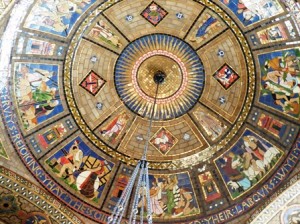 settlers used what they had. And that was sod.” There was a group “ohh” from the children as they thought about that. Jamison continued with the beginnings of Nebraska, pictured right there in the vestibule of the capitol. The capitol’s art is “themed” from beginning to end, reflecting the values of the people of Nebraska. There’s hushed behavior here; the building feels cathedral-like; especially looking up.
settlers used what they had. And that was sod.” There was a group “ohh” from the children as they thought about that. Jamison continued with the beginnings of Nebraska, pictured right there in the vestibule of the capitol. The capitol’s art is “themed” from beginning to end, reflecting the values of the people of Nebraska. There’s hushed behavior here; the building feels cathedral-like; especially looking up.
The grandma and I kept finding benches as Jamison led the children from one dramatic scene 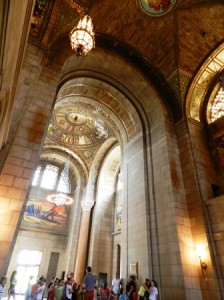 to the next; soaring arches lifted our vision to the very top. “I can’t believe how they did all this,” grandma said. I couldn’t believe it either; the rest of this post is straight from their brochure; I didn’t dare leave anything out.
to the next; soaring arches lifted our vision to the very top. “I can’t believe how they did all this,” grandma said. I couldn’t believe it either; the rest of this post is straight from their brochure; I didn’t dare leave anything out.
The Vestibule. The theme here is Gifts of Nature to Man on the Plains. The sun, an important gift of nature, is represented in the top of the dome, the chandelier and the large floor mosaic. The outer border of the dome contains the inscription: Behold they come as householders, bringing earth’s first fruits, rejoicing that the soil hath rewarded their labors with the abundance of its seasons. The pendentives surrounding the dome portray the four seasons of agriculture. The arches around the dome are filled with native fauna of Nebraska. The three large wall murals were painted by James Penney and added in 1964. In sunset colors Penney painted The Homesteader’s Campfire, The First Furrow, and The House Raising.
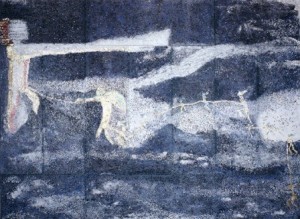 The Foyer. The theme of the Foyer is the Life of Man. On the floor are three mosaics which represent the Earth, The Spirit of the Soil, The Spirit of Vegetation, and The Spirit of Animal Life. The three medallions in the ceiling represent Traditions of the Past, Life of the Present, and Ideas of the Future. The window arches contain figures to represent the activities of society: Family, School, Recreation, Reflection, Beauty, and Truth. The four inward-facing ceiling panels symbolize Law, Labor, Public Spirit, and Religion. The six large mosaics on the walls were commissioned to celebrate Nebraska’s Centennial in 1967. They are: The United State Survey, The Blizzard of 1888, Tree Planting, The Coming of the Railroad, The Spirit of Nebraska, and The Building of the Capitol. (Jamison explained the concept of “abstract art” to the children, telling the story of the schoolteacher who saved the children in the blizzard of 1888 by leading them out of the storm, see above.)
The Foyer. The theme of the Foyer is the Life of Man. On the floor are three mosaics which represent the Earth, The Spirit of the Soil, The Spirit of Vegetation, and The Spirit of Animal Life. The three medallions in the ceiling represent Traditions of the Past, Life of the Present, and Ideas of the Future. The window arches contain figures to represent the activities of society: Family, School, Recreation, Reflection, Beauty, and Truth. The four inward-facing ceiling panels symbolize Law, Labor, Public Spirit, and Religion. The six large mosaics on the walls were commissioned to celebrate Nebraska’s Centennial in 1967. They are: The United State Survey, The Blizzard of 1888, Tree Planting, The Coming of the Railroad, The Spirit of Nebraska, and The Building of the Capitol. (Jamison explained the concept of “abstract art” to the children, telling the story of the schoolteacher who saved the children in the blizzard of 1888 by leading them out of the storm, see above.)
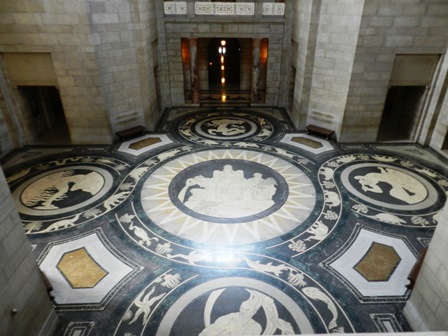 The Rotunda. The floor plan of the Capitol is a cross within a square; the Rotunda, 112 feet tall, is located at the intersection of the arms of the cross in the center of the building. The theme of the Rotunda is Virtues of the State. The eight winged figures in the dome form a celestial rose representing civic and sacred virtues: Temperance, Courage, Justice, Wisdom, Magnanimity, Faith, Hope, and Charity. The large marble floor mosaic in the center of the Rotunda floor is Earth as the Life-giver and surrounding her are symbols of Water, Fire, Air, and Soil. Prehistoric life of Nebraska is shown in the border surrounding the elements.
The Rotunda. The floor plan of the Capitol is a cross within a square; the Rotunda, 112 feet tall, is located at the intersection of the arms of the cross in the center of the building. The theme of the Rotunda is Virtues of the State. The eight winged figures in the dome form a celestial rose representing civic and sacred virtues: Temperance, Courage, Justice, Wisdom, Magnanimity, Faith, Hope, and Charity. The large marble floor mosaic in the center of the Rotunda floor is Earth as the Life-giver and surrounding her are symbols of Water, Fire, Air, and Soil. Prehistoric life of Nebraska is shown in the border surrounding the elements.
The inscriptions at the springing line of the room’s vaults are taken from Aristotle’s Politics:
- HE WHO WOULD DULY ENQUIRE ABOUT THE BEST FORM OF THE STATE OUGHT FIRST TO DETERMINE THE MOST ELIGIBLE LIFE
- MEN SHOULD NOT THINK IT SLAVERY TO LIVE ACCORDING TO THE RULE OF THE CONSTITUTION FOR IT IS THEIR SALVATION
- A COMMUNITY LIKE AN INDIVIDUAL HAS A WORK TO DO
and from Plato’s Dialogs:
- LAWS AND CONSTITUTIONS SPRING FROM THE MORAL DISPOSITIONS OF THE MEMBERS OF THE STATE
- LAW AND ORDER DELIVER THE SOUL
The three large murals were added in 1956. They represent Industrial Enterprises, 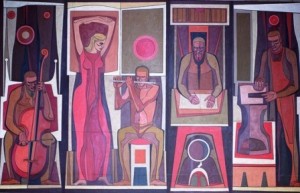 Intellectual Works, and Humanitarian Works, and are titled The Labors of the Hand, The Labors of the Head, and The Labors of the Heart.
Intellectual Works, and Humanitarian Works, and are titled The Labors of the Hand, The Labors of the Head, and The Labors of the Heart.
The East and West Chambers. In the east and west arms of the cross, which is centered on the Rotunda, are the two chambers of Nebraska’s legislature. Nebraska had a bicameral government until 1937, when the Unicameral was formed. The West Chamber was chosen to house the new single governmental body because it was the larger of the two chambers. The two chambers are decorated to represent the two groups which brought their cultures into the Plains.
 The East Chamber symbolizes the aboriginal life of the Indian. It was renamed the Warner Legislative Chamber to honor the Warner family and their contributions to the growth of the Unicameral system in Nebraska. Hildreth Meiere’s ceiling mosaics within the chamber represent the daily activities of the Native American cultures of the Plains: women hoeing corn, a war party, a tribal council, and a buffalo hunt. The mosaics and decorative borders were designed to look like Native American beadwork.
The East Chamber symbolizes the aboriginal life of the Indian. It was renamed the Warner Legislative Chamber to honor the Warner family and their contributions to the growth of the Unicameral system in Nebraska. Hildreth Meiere’s ceiling mosaics within the chamber represent the daily activities of the Native American cultures of the Plains: women hoeing corn, a war party, a tribal council, and a buffalo hunt. The mosaics and decorative borders were designed to look like Native American beadwork.
 The West Legislative Chamber is decorated with scenes of the westward migration of the three nations to claim political control of Nebraska – Spain, France, and the United States. The leather doors of the West Chamber show the agricultural foundation of Western Civilization in the ancient middle eastern region, with the Assyrian man and woman planting a tree of life under an Egyptian sun. The Speaker’s Niche in the West Chamber features a mosaic pattern of stylized prairie flowers and ears of corn. The bronze voting panel was the first electronic voting panel originally installed in a state capitol.
The West Legislative Chamber is decorated with scenes of the westward migration of the three nations to claim political control of Nebraska – Spain, France, and the United States. The leather doors of the West Chamber show the agricultural foundation of Western Civilization in the ancient middle eastern region, with the Assyrian man and woman planting a tree of life under an Egyptian sun. The Speaker’s Niche in the West Chamber features a mosaic pattern of stylized prairie flowers and ears of corn. The bronze voting panel was the first electronic voting panel originally installed in a state capitol.
The Supreme Court. Once each month, the Nebraska Supreme Court’s seven appointed justices hear oral arguments in an acoustically perfect chamber. The Supreme Court 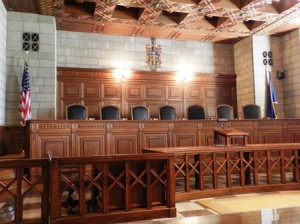 Chamber and its furnishings are constructed of American Walnut wood. The public benches, wainscoting, railing, and attorney’s tables and chairs are solid walnut. The Justice’s bench at the front of the Chamber is inlaid with many different kinds of wood. The frieze of the walnut paneled wall behind the bench is inlaid with an inscription from Heraclitus:
Chamber and its furnishings are constructed of American Walnut wood. The public benches, wainscoting, railing, and attorney’s tables and chairs are solid walnut. The Justice’s bench at the front of the Chamber is inlaid with many different kinds of wood. The frieze of the walnut paneled wall behind the bench is inlaid with an inscription from Heraclitus:
- EYES AND EARS ARE POOR WITNESSES WHEN THE SOUL IS BARBAROUS
The 8,000-piece carved walnut ceiling aids in the acoustical quality of the Chamber. It has coffers which along with the Guastavino Acoustic Tile walls capture sound waves and prevent echoes. The public is welcome to attend the court’s sessions and enter from the rear of the Chamber. There are three large tapestries decorating the walls. Hand woven with natural fibers and dyes, the tapestries represent the early exploration and settlement of the Louisiana Territory.
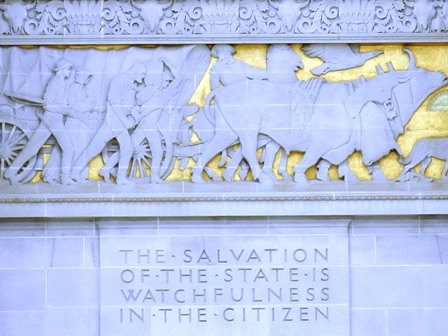 The Capitol. The building was constructed over a ten year period in four building phases. Construction began in 1922 and was completed in 1932. Total cost of the building was just under $10 million. The team who built it was composed of Architect Bertram Grosvenor Goodhue, Sculptor Lee Lawrie, Artist Hildreth Meiere, and Philosopher Hartley Burr Alexander.
The Capitol. The building was constructed over a ten year period in four building phases. Construction began in 1922 and was completed in 1932. Total cost of the building was just under $10 million. The team who built it was composed of Architect Bertram Grosvenor Goodhue, Sculptor Lee Lawrie, Artist Hildreth Meiere, and Philosopher Hartley Burr Alexander.
Nebraska State Capitol, K Street, between 14th and 16th Streets, 402- 471–0448, open daily, tours hourly, http://capitol.org/
